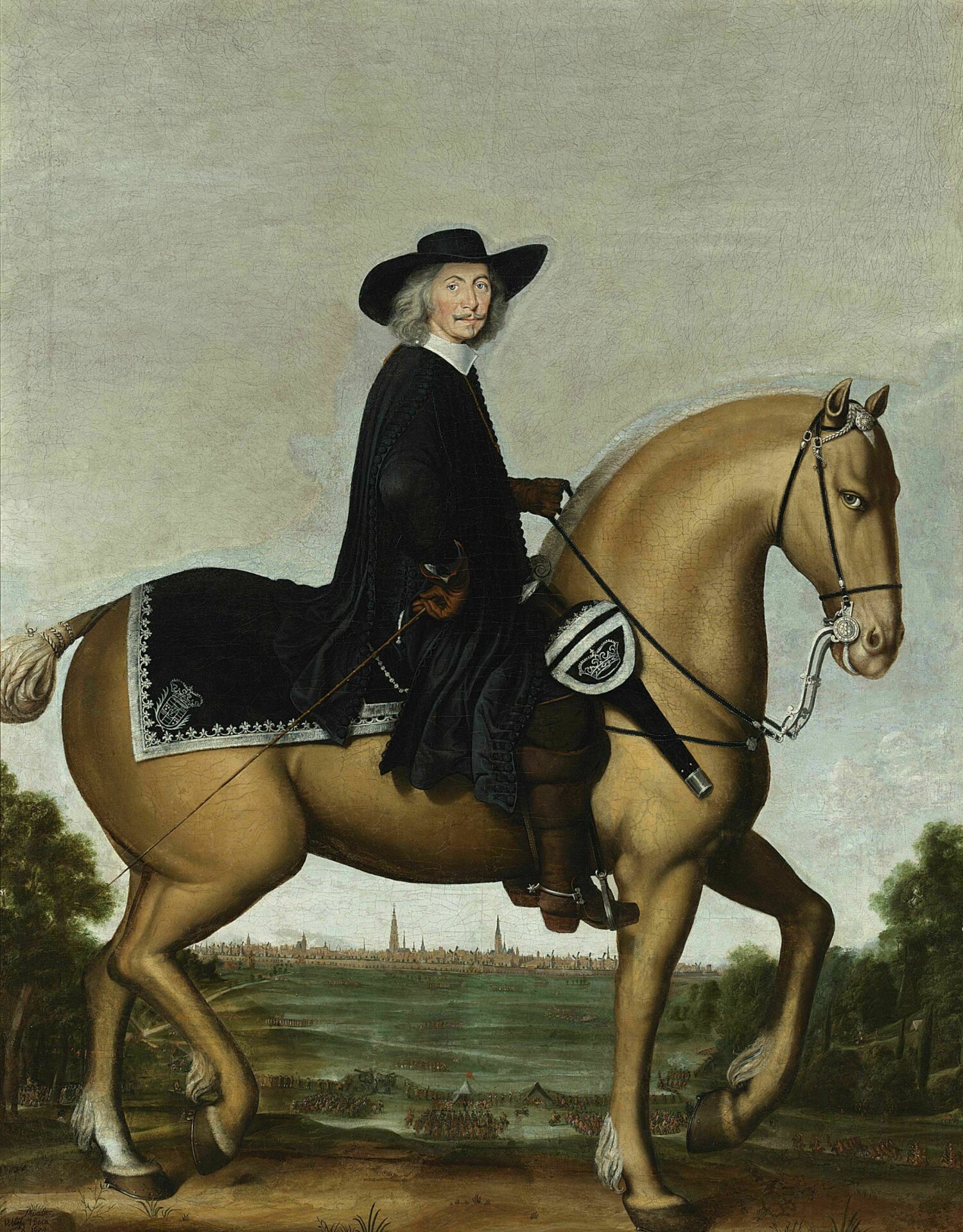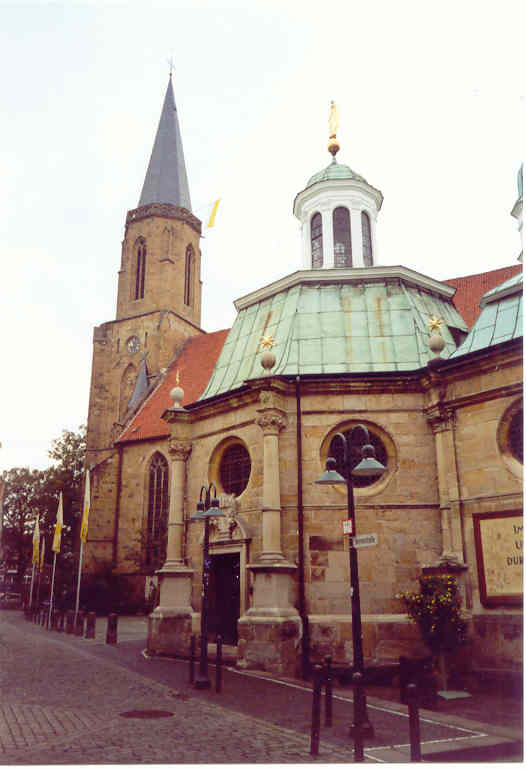|
Telgte Pilgrimage
The pilgrimage from Osnabr├╝ck to Telgte takes place since 1852 on the second Sunday after the Feast of Saints Peter and Paul; it is known as Telgte pilgrimage ("Telgter Wallfahrt") or Osnabr├╝ck pilgrimage ("Osnabr├╝cker Wallfahrt (nach Telgte)"). Each year approximately 8,000 pilgrims participate in the 47 km long walk along the B51 and more visitors arrive by bus or car. History The pilgrimage was started by layman citizen of Osnabr├╝ck in 1852, approved by the Catholic Church under the condition, that no spirits or other alcoholic beverages will be drunk. In 1856 the procession was led for the first time by a priest. Despite an interdiction during the wars in 1864-1866 (Second War of Schleswig) and 1914-1918 (World War I), during the Kulturkampf 1872-1882 and during Nazi Germany 1938-1944 many people went in small groups or alone on the pilgrimage to Telgte. Object of veneration The object of veneration is the statue of the painful Blessed Virgin Mary. It shows Mary, hol ... [...More Info...] [...Related Items...] OR: [Wikipedia] [Google] [Baidu] |
Osnabr├╝ck
Osnabr├╝ck (; wep, Ossenbr├╝gge; archaic ''Osnaburg'') is a city in the German state of Lower Saxony. It is situated on the river Hase in a valley penned between the Wiehen Hills and the northern tip of the Teutoburg Forest. With a population of 168,145 Osnabr├╝ck is one of the four largest cities in Lower Saxony. The city is the centrepoint of the Osnabr├╝ck Land region as well as the District of Osnabr├╝ck.Osnabr├╝ck: Lebendiges Zentrum im Osnabr├╝cker Land www.osnabruecker-land.de The founding of Osnabr├╝ck was linked to its positioning on important European trading routes. |
Piet├Ā
The Piet├Ā (; meaning "pity", "compassion") is a subject in Christian art depicting the Virgin Mary cradling the dead body of Jesus after his body was removed from the cross. It is most often found in sculpture. The Piet├Ā is a specific form of the Lamentation of Christ in which Jesus is mourned by the Virgin Mary alone. Context and development Piet├Ā is one of the three common artistic representations of a sorrowful Virgin Mary, the other two being Mater Dolorosa (Mother of Sorrows) and Stabat Mater (the mother was standing). The other two representations are most commonly found in paintings, rather than sculpture, although combined forms exist. The Piet├Ā developed in Germany (where it is called the "Vesperbild") about 1300, reached Italy about 1400, and was especially popular in Central European Andachtsbilder. Many German and Polish 15th-century examples in wood greatly emphasise Christ's wounds. The Deposition of Christ and the Lamentation or Piet├Ā form the 13th of th ... [...More Info...] [...Related Items...] OR: [Wikipedia] [Google] [Baidu] |
Piet├Ā
The Piet├Ā (; meaning "pity", "compassion") is a subject in Christian art depicting the Virgin Mary cradling the dead body of Jesus after his body was removed from the cross. It is most often found in sculpture. The Piet├Ā is a specific form of the Lamentation of Christ in which Jesus is mourned by the Virgin Mary alone. Context and development Piet├Ā is one of the three common artistic representations of a sorrowful Virgin Mary, the other two being Mater Dolorosa (Mother of Sorrows) and Stabat Mater (the mother was standing). The other two representations are most commonly found in paintings, rather than sculpture, although combined forms exist. The Piet├Ā developed in Germany (where it is called the "Vesperbild") about 1300, reached Italy about 1400, and was especially popular in Central European Andachtsbilder. Many German and Polish 15th-century examples in wood greatly emphasise Christ's wounds. The Deposition of Christ and the Lamentation or Piet├Ā form the 13th of th ... [...More Info...] [...Related Items...] OR: [Wikipedia] [Google] [Baidu] |
Ostbevern
Ostbevern is a municipality in the district of Warendorf, in North Rhine-Westphalia, Germany. Geography Ostbevern is situated on the river Bever, approx. 18 km north-east of M├╝nster and 18 km north-west of Warendorf. Neighbouring municipalities Ostbevern borders Ladbergen, Lienen, Glandorf (in Lower Saxony), Warendorf, Telgte and Greven. Division of the town The municipality Ostbevern consists of the village Ostbevern, the district Brock and the surrounding farming land. History In 1088 Bevern was first mentioned in an official document under the name ''Beverne''. Presumably in the 12th century the parish Bevern was split into Ostbevern and Westbevern (which is now part of Telgte). During the Napoleonic Wars the municipality first fell to Prussia, then to Berg. Since 1810 it then belonged to the French Empire, until Ostbevern was assigned to prussia again at the Congress of Vienna. Since World War II Ostbevern lies in North Rhine-Westphalia. Politics Communal ... [...More Info...] [...Related Items...] OR: [Wikipedia] [Google] [Baidu] |
Glandorf, Germany
Glandorf is a municipality in the district of Osnabr├╝ck, in Lower Saxony, Germany. It is situated close to the Teutoburg Forest, 24 km south of Osnabr├╝ck. The name Glandorf derives from ''Glanathorpe'' - which means ''settlement on the creek Glane'' - and was first mentioned in records in 1070. The municipality includes Glandorf and six local subdivisions which are Averfehrden (formerly Narendorf), Schierloh, Schwege, Sudendorf, Westendorf, and Laudiek. Glandorf's landmark is a windmill that is constructed following the example of Dutch windmill design. It was built in 1840. Since 2000, civil weddings can be celebrated in the windmill. Churches The oldest parts of the Roman Catholic Church St. Johannis (St. John the Baptist) date from the 13th century and were documentary mentioned the first time in 1275. In 1636 the church was burned down by Swedish troops during the Thirty Years' War and was rebuilt with the old material. Between 1817 and 1820 a complete modification of ... [...More Info...] [...Related Items...] OR: [Wikipedia] [Google] [Baidu] |
Bad Iburg
Bad Iburg (; Westphalian: ''Bad Ibig'') is a spa town in the district of Osnabr├╝ck, in Lower Saxony, Germany. It is situated in the Teutoburg Forest, 16 km south of Osnabr├╝ck. Bad Iburg is also the name of a municipality which includes the town and four outlying centres: Glane, Ostenfelde, Sentrup and Visbeck. The most important building is Schloss Iburg above the town. It is a complex of a castle which was the residence of the bishops of Osnabr├╝ck for six hundred years and a former monastery of the Order of Saint Benedict. History Bad Iburg was first mentioned in 753 in a Frankish document. In 772 the Frankish King Charlemagne captured the ŌĆ£Royal castle IburgŌĆØ, from his chief antagonist, the Saxon leader Widukind. In a lasting period of struggles the ownership changed between Franks and Saxons. Frankish troops finally regained the castle in 783. Bad Iburg became of more than local importance in the 11th century when Bishop Benno I (1052ŌĆō1067) built a new ... [...More Info...] [...Related Items...] OR: [Wikipedia] [Google] [Baidu] |
Georgsmarienh├╝tte
Georgsmarienh├╝tte () is a town in the district of Osnabr├╝ck, in Lower Saxony, Germany. It is situated in the Teutoburg Forest, approx. 7 km south of Osnabr├╝ck. History In 1856 the company "Georgs-Marien-Bergwerks- und H├╝ttenverein" was founded to erect an iron and steel works in the municipality of Malbergen. It was named after King George V of Hanover who supported industrial development, and his wife Marie. The workersŌĆÖ housing estates grew and developed to the municipality Georgsmarienh├╝tte. Malbergen became part of Georgsmarienh├╝tte in 1937. In 1970, the municipalities Oesede, Kloster Oesede, Harderberg, Holsten-M├╝ndrup, the southern part of Holzhausen and the "industrial village" Georgsmarienh├╝tte were united to the city Georgsmarienh├╝tte. The iron and steel works were one of the most important employers south of Osnabr├╝ck, employing several thousand people. Since 1923 it belonged to Kl├Čckner Werke AG which suffered severely from the steel crises of the 1 ... [...More Info...] [...Related Items...] OR: [Wikipedia] [Google] [Baidu] |
Mass (liturgy)
Mass is the main Eucharistic liturgical service in many forms of Western Christianity. The term ''Mass'' is commonly used in the Catholic Church, in the Western Rite Orthodox, in Old Catholic, and in Independent Catholic churches. The term is used in some Lutheran churches, as well as in some Anglican churches. The term is also used, on rare occasion, by other Protestant churches. Other Christian denominations may employ terms such as '' Divine Service'' or ''worship service'' (and often just "service"), rather than the word ''Mass''. For the celebration of the Eucharist in Eastern Christianity, including Eastern Catholic Churches, other terms such as ''Divine Liturgy'', '' Holy Qurbana'', ''Holy Qurobo'' and ''Badarak'' (or ''Patarag'') are typically used instead. Etymology The English noun ''mass'' is derived from the Middle Latin . The Latin word was adopted in Old English as (via a Vulgar Latin form ), and was sometimes glossed as ''sendnes'' (i.e. 'a sending, dismiss ... [...More Info...] [...Related Items...] OR: [Wikipedia] [Google] [Baidu] |
Bernhard Von Galen
Christoph Bernhard Freiherr von Galen (12 October 1606, Drensteinfurt ŌĆō 19 September 1678) was Prince-bishop of M├╝nster. He was born into a noble Westphalian family. Background, education and conversion to Roman Catholicism Christoph Bernhard von Galen was born on 12 October 1606 to Lutheran parents of the aristocratic von Galen family. His father, Dietrich von Galen, had estates in the Baltic region and bore the title of Marshal of Courland. During a state assembly in M├╝nster, Dietrich von Galen killed the M├╝nster hereditary marshal, Gerd Morrien zu Nordkirchen, on 15 February 1607, and consequently had to spend twelve years in detention at Bevergern Castle. Because his wife accompanied him voluntarily, in 1616 the young Christoph Bernhard was placed under the care of his uncle, the Canon of M├╝nster, Heinrich von Galen. He gave him a Catholic education by Jesuits at the Paulinum in M├╝nster. In 1619, at 13, he took his first job working for the cathedral chapter in M ... [...More Info...] [...Related Items...] OR: [Wikipedia] [Google] [Baidu] |
Jesus
Jesus, likely from he, ūÖųĄū®ūüūĢų╝ūóųĘ, translit=Y─ō┼Ī┼½a╩┐, label=Hebrew/Aramaic ( AD 30 or 33), also referred to as Jesus Christ or Jesus of Nazareth (among other names and titles), was a first-century Jewish preacher and religious leader; he is the central figure of Christianity, the world's largest religion. Most Christians believe he is the incarnation of God the Son and the awaited Messiah (the Christ) prophesied in the Hebrew Bible. Virtually all modern scholars of antiquity agree that Jesus existed historically. Research into the historical Jesus has yielded some uncertainty on the historical reliability of the Gospels and on how closely the Jesus portrayed in the New Testament reflects the historical Jesus, as the only detailed records of Jesus' life are contained in the Gospels. Jesus was a Galilean Jew who was circumcised, was baptized by John the Baptist, began his own ministry and was often referred to as "rabbi". Jesus debated with fellow Jews on ho ... [...More Info...] [...Related Items...] OR: [Wikipedia] [Google] [Baidu] |
Telgte
Telgte (German pronunciation: łt╔ølkt╔Ö regionally łt╔øl├¦t╔Ö is a town in the Warendorf district, North Rhine-Westphalia, Germany, on the river Ems 12 km east of M├╝nster and 15 km west of Warendorf. Telgte is famous as a place of pilgrimage, the Marian pilgrimage from Osnabr├╝ck to Telgte. Geography Neighboring Communities Telgte borders the cities M├╝nster, Geven, Ostbevern, Warendorf, and Everswinkel. City Districts Telgte divides into the main city and two districts, Westbevern-Dorf and Westbevern-Vadrup. Until 1974, Westbevern (population: about 4000; area of 24,46 km┬▓) was an independent town, with Dorf, Vadrup, and Brock as its districts. Since the reform of the municipal area reform, Brock has been a part of the neighboring town Ostbevern. The Bever runs as a tributary to the Ems through Westbevern. With its double-mill at the Bever, Haus Langen is a popular destination for tourists. For a couple of years, the neo-gothic church St Cornelius ... [...More Info...] [...Related Items...] OR: [Wikipedia] [Google] [Baidu] |





